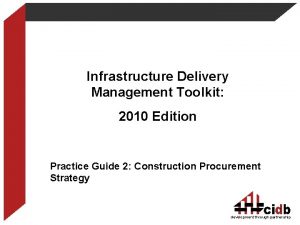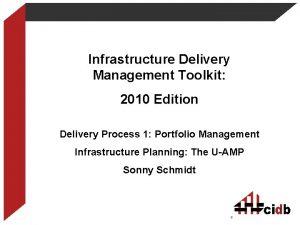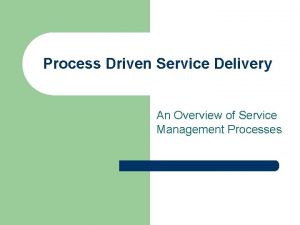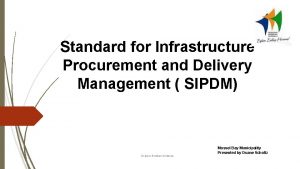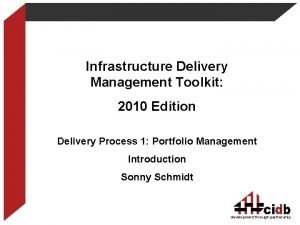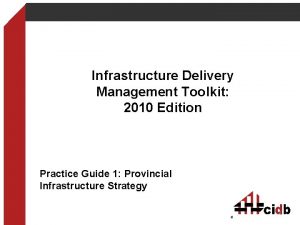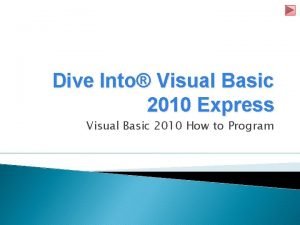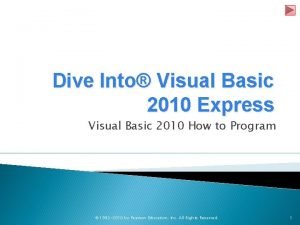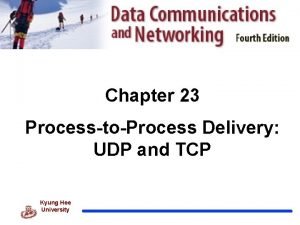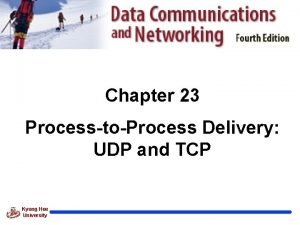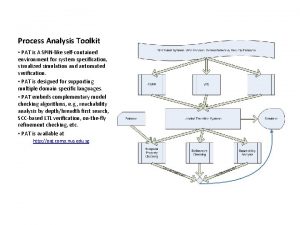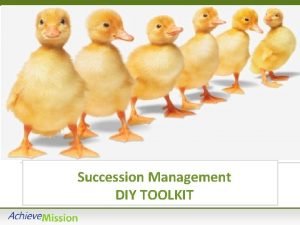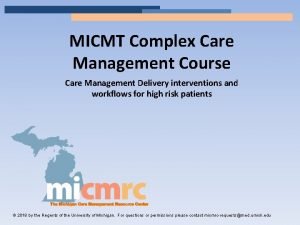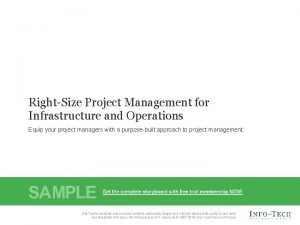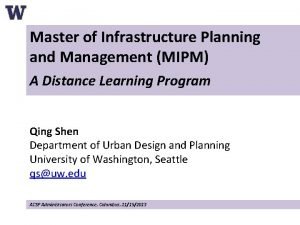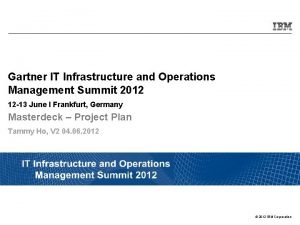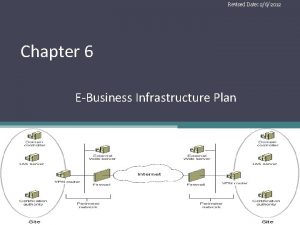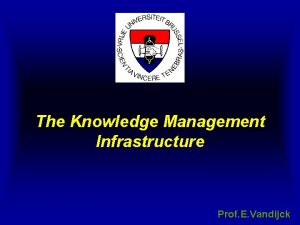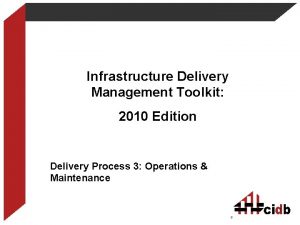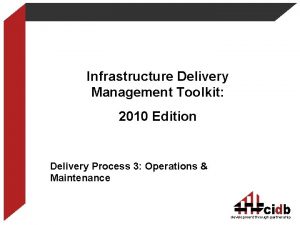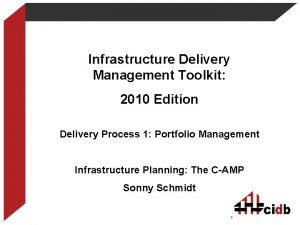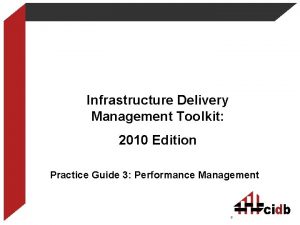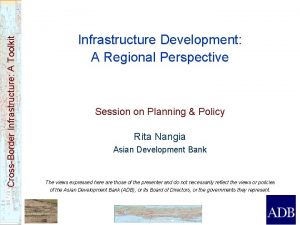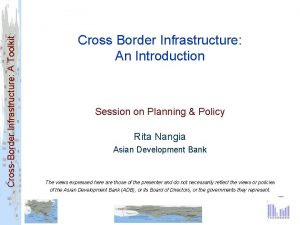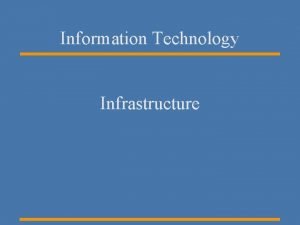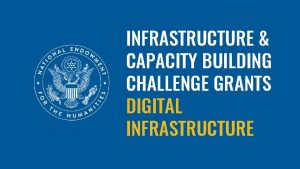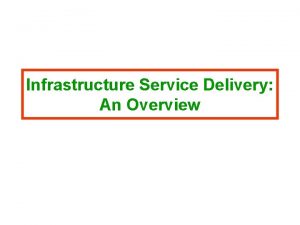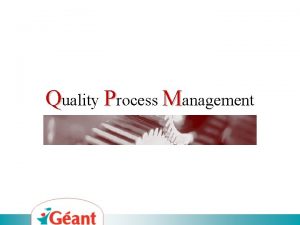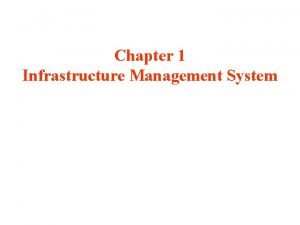Infrastructure Delivery Management Toolkit 2010 Edition Delivery Process



























- Slides: 27

Infrastructure Delivery Management Toolkit: 2010 Edition Delivery Process 2: Project Management 1 development through partnership

Contents of this presentation • • • Introduction to Project Management Context within the Toolkit Process map Project Stages Contracting Strategies: influence on project stages 2 development through partnership

Introduction to Project Management (1) Traditional Project Management Approach: Based on: Sequential Logic & Single point of Responsibility Phases: – Initiate – Plan – Design (if required) – Execute the Works – Close Out

Introduction to Project Management (2) Projects Initiated during the Portfolio Planning Process: aimed at effectiveness, i. e. “doing the right things” Goal: Approval of Budget: Authorisation to spend Project Implementation: – Plan “doing the – Design (if required) things right” – Execute the Works – Close Out

Purpose of Project Planning (1): Project Objectives Scope/Quality Cost Time

Purpose of Project Planning (2): Project Objectives What the Client Dept wants! • Scope • Quality = the product/facility • Time • Cost Determined based on Resource Requirements (given Assumptions and Constraints)

The Importance of Project Objectives Conceptual Planning happens here in Portfolio Planning Process! Start Finish Timeline Project Success measured here! (in terms of the achievement of the stated Objectives!)

The Importance of Project Objectives Planning happens throughout! Start Progressive Elaboration Finish Timeline Project Success measured in terms of Updated Objectives!

Project Planning Deliverables Scope/Quality Strategic Brief; Concept Report; Design Dev Report; Tender Documentation Cost Estimates Cost Specifications; Standards Time Estimates: Schedule Time


Process map

Project Stages with Sub Stages: 1. Planning 1. Package Preparation 2. Package Definition 3. Works Planning 2. Design 1. Concept Design 2. Detail design & Specification 3. Manufacturing, Fabrication, Construction Information 3. Works 1. Construct/Deliver the Works 2. Handover of the Works 4. Close Out 1. Project Close Out 2. Post Project Evaluation

Project phases Project Phasing/Goals/Deliverables: Phase 1: Planning • Phase 1. 1: Package Preparation (Defining the package objectives, business need, acceptance criteria and client priorities and aspirations; Confirming the scope of the package; Establishing the control budget; Developing a Strategic Brief ) Gate 3: Accepted PEPv 1 & Strategic Brief Phase 1. 2: Package Definition (Establishing the feasibility of satisfying the strategic brief; Investigating alternative solutions; Selecting the preferred design option; Determining the initial design criteria, design options and cost plan; Developing a Concept Report) Gate 4: Accepted PEP v 2 & Concept Report Phase 1. 3: Works Planning (Preparing Project Execution Plan (PEP) for each project; Summarising of PEPs at programme level for each User Department (IPIP))

Project phases Project Phasing/Goals/Deliverables: Phase 2: Design • Phase 2. 1: Concept Design (Develop in detail the accepted concept to finalise the design and definition criteria) Gate 5: Accepted PEP v 3 & Design Development Report Phase 2. 2: Detail Design and Specification (Produce the final detailing, performance definition, specification, sizing and positioning of all systems and components enabling either construction (where the contractor is able to build directly from the information prepared) or the production of manufacturing and installation information for construction. ) Gate 6 a: Accepted PEP v 4 & Production Information) Phase 2. 3: Manufacture, fabrication and construction information (Client’s agents: Review the manufacture, fabrication and construction information prepared by others, based on the production information for design intent and conformance with scope of work. Contractor: Produce the manufacture, fabrication and construction information based on the production information) Gate 6 b: Accepted Manufacture, Fabrication & Construction information

Project phases Project Phasing/Goals/Deliverables: Phase 3: Works • Phase 3. 1: Construct/Deliver the Works (Provide temporary works Provide permanent works in accordance with the contract Manage risks associated with health and safety on the site Corrected notified defects which prevented the client or end user from using the works and others from doing their work) Gate 7: Accepted PEP 5 - works in accordance with requirements Phase 3. 2: Handover the Works (Correct all notified defects; Commission works and, if necessary, train end user staff in the operation of the works) Gate 8: Works taken over by User, complete with record information

Project phases Project Phasing/Goals/Deliverables: Phase 4: Close Out • Phase 4. 1: Project Close Out (Finalise and assemble record information and obtain outstanding statutory certificates Project Audit) • Phase 4. 2: Post Project Evaluation (Conduct post-project review and capture data Post Project Evaluation)

Project phases Project Implementation Phases: – – Planning Design Works Close Out Procurement Phases?

Contracting strategies Summary of Contracting Strategies: – Design by Employer – Management Contract – Design and Construct – Develop and Construct The preferred Contracting Strategy will result in the Insertion of the Procurement Phase(s) at different points in project life span

Contractor Involvement

PUBLIC SECTOR PROJECT MANAGEMENT METHODOLOGY FOR PACKAGES WITH NO DESIGN INPUTS 20

Public Sector Project Management Methodology for Design by Employer Packages

Public Sector Project Management Methodology for Develop and Construct (Dev&C) Packages

Public Sector Project Management Methodology for Design and Construct (D&C) Packages

Public Sector Project Management Methodology for Management Contract Strategy

The Project Execution Plan ( “PEP”) Short summary of the Project: • Project Detail • Team Detail (Roles and Roleplayers) • Client Department • Implementing Department/Agent • PSPs • Contractors(s) Summary of Project ‘Status’ at each “Gate”: • Scope/Quality (changes from previous Gate) • (Revised) Milestone Schedule (NB: Procurement schedule) • (Revised) Cost Estimates and Expenditure Projections (show separate for each Service Provider) Summary of Variation Orders Project Issue Log 25

The Infrastructure Programme Implementation Plan (“IPIP”) • A Portfolio Level summary of all Programmes • A Programme Level summary of all Projects in a specific Programme Based on the PEPs, with focus on Time and Cost, i. e. • Project Schedule • Expenditure Projections • Budget Analysis • Programme Budget • Project Budgets • FY Budget 26

Conclusion and questions Thank you 27
 Infrastructure delivery management
Infrastructure delivery management Infrastructure delivery management toolkit
Infrastructure delivery management toolkit Infrastructure delivery management toolkit
Infrastructure delivery management toolkit Service delivery process in it infrastructure
Service delivery process in it infrastructure Infrastructure delivery management system
Infrastructure delivery management system Infrastructure delivery management system
Infrastructure delivery management system Infrastructure delivery management system
Infrastructure delivery management system Visual basic 2010 ide
Visual basic 2010 ide Visual basic express 2010
Visual basic express 2010 Using mis (10th edition) 10th edition
Using mis (10th edition) 10th edition Report
Report What is process to process delivery
What is process to process delivery Process-to-process delivery
Process-to-process delivery Process analysis toolkit
Process analysis toolkit Talent review chart
Talent review chart Complex care management toolkit
Complex care management toolkit Enemy corner seating arrangement
Enemy corner seating arrangement Adm for da accenture
Adm for da accenture It infrastructure project management best practices
It infrastructure project management best practices Masters in infrastructure planning and management
Masters in infrastructure planning and management Gartner infrastructure and operations summit
Gartner infrastructure and operations summit Change management network infrastructure
Change management network infrastructure Key management issues of e business infrastructure
Key management issues of e business infrastructure Five-layer model of e business infrastructure
Five-layer model of e business infrastructure Knowledge management infrastructure
Knowledge management infrastructure Privilege management infrastructure
Privilege management infrastructure Infrastructure and asset management
Infrastructure and asset management Gartner it operations management
Gartner it operations management
